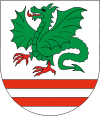Garwolin
Coordinates: 51°54′N 21°37′E / 51.900°N 21.617°E

| Garwolin | |||
|---|---|---|---|
| |||
 Garwolin | |||
| Coordinates: 51°54′N 21°38′E / 51.900°N 21.633°E | |||
| Country |
| ||
| Voivodeship | Masovian | ||
| County | Garwolin County | ||
| Gmina | Garwolin (urban gmina) | ||
| Town rights | 15th century | ||
| Government | |||
| • Mayor | Tadeusz Mikulski | ||
| Area | |||
| • Total | 22.08 km2 (8.53 sq mi) | ||
| Population (2009) | |||
| • Total | 16,710 | ||
| • Density | 760/km2 (2,000/sq mi) | ||
| Time zone | CET (UTC+1) | ||
| • Summer (DST) | CEST (UTC+2) | ||
| Postal code | 08-400 | ||
| Area code(s) | +48 25 | ||
| Car plates | WG | ||
| Website | http://www.garwolin.pl | ||
Garwolin [ɡarˈvɔlʲin] is a town on the Wilga river in eastern Poland, capital of Garwolin County, situated in the southeast part of the Garwolin plateau in Masovian Voivodeship (since 1999, before: Siedlce Voivodeship), 62 km southeast of Warsaw, 100 km northwest of Lublin. There are about 16,000 inhabitants in the town.
History
Traces of settlement on terrains of present days boundaries of Garwolin are more than 2000 years old. It is believed that Garwolin received its city charter in 1423, but the exact date is unknown; it is almost certain that the document from 1423 was only acknowledgement of before-stated city laws. In time of the Deluge casualties exceeded 90%.
During World War II and the Nazi occupation of Poland, about 70% of the city was destroyed. The town and the powiat were administered by Kreishauptmann Karl Freudenthal, who was responsible for the murder of more than 1000 inhabitants, the deportation of several thousand local Poles to Nazi concentration camps and slave labor in Nazi Germany, and the transfer of the local Jews to various ghettos in the region. For his war crimes, Freudenthal was sentenced to death by the Polish underground, and the sentence was carried out by the Home Army on 5 July 1944, as part of Operacja Główki ("Operation Heads").
At the end of July 1944 the Red Army's 2nd Guards Tank Army, under the command of Alexei Radzievsky, routed the German 73rd Infantry Division at Garwolin, capturing its commander, Friedrich Franek.[1]
After the war Garwolin was restored and enlarged. The Neo-baroque church, dating from the turn of the 19th and 20th centuries, is a notable building.
Education
- the Józef Piłsudski grammar school,
- two vocational schools,
- Academy of Management in Łódź, branch in Garwolin.
Economy
Centre of industry and services; machine, means of transport, nutritive (milk co-operative, meat) industries, clothing, leather, construction materials, furniture and cosmetics manufactures.
Transport
- Principal road #17: direction Warsaw-Garwolin-Lublin-Hrebenne,
- Principal road #76: direction Łuków-Garwolin-Wilga.
In distance of 5 km from town railway route Warszawa-Lublin proceeds; station Garwolin is placed in nearby village Wola Rębkowska.
Sport & Culture
- "Wilga" Cinema 3D,
- Centre of Sports and Culture,
- "Garwolanka" Swimming pool,
- Wilga Garwolin Sports Club.
Notes
External links
| Wikimedia Commons has media related to Garwolin. |
- County of Garwolin
- City's Hall Official Page
- Garwolin County's Community Association
- Community of Garwolin
- Jewish Community in Garwolin on Virtual Shtetl


